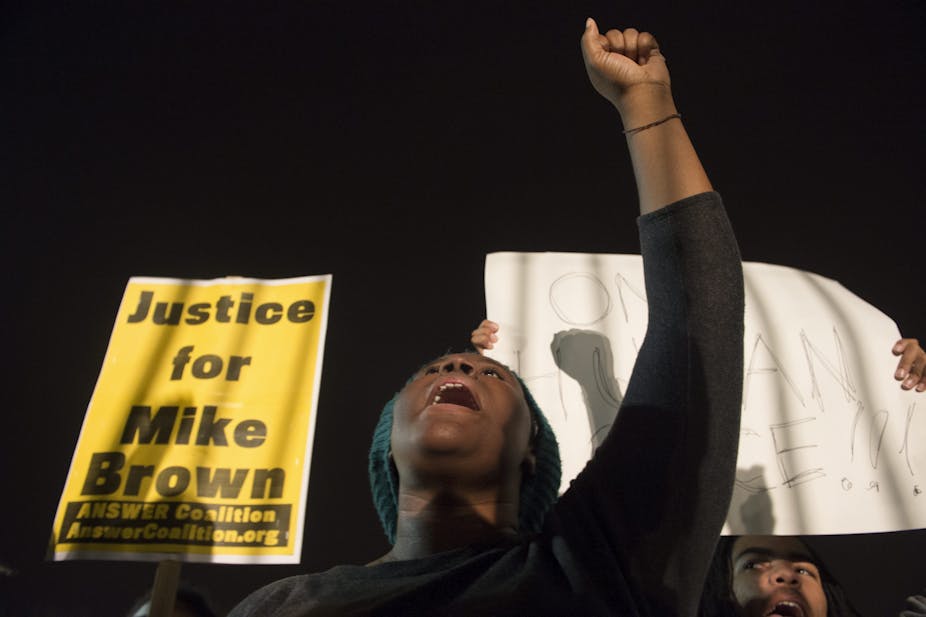The idea of the grand jury is already familiar to many Australians through American television legal drama. But its profile just skyrocketed with a grand jury deciding not to indict policeman Darren Wilson over the shooting death of 18-year-old Michael Brown in Ferguson, Missouri.
But just how “grand” is the grand jury? And why doesn’t the system exist in Australia?
History of grand juries
A grand jury is composed of between 16 and 23 citizens who have the evidence against a criminal defendant presented to them by a prosecutor. The role of the grand jury is to decide whether to “indict” the defendant, which means decide if they should face trial or not. The grand jury can compel witnesses to appear, or require documents or physical evidence to be produced.
If a grand jury decides to indict, the defendant goes to trial before a “petit” or trial jury of 12 people, in the same way as they do in Australia.
While English in origin, the grand jury now exists only in the US. Even there only about half of the jurisdictions still use them. Grand juries arose during the time that criminal prosecutions were brought by private individuals and were intended to ensure that accusers did not have malicious motives.
As public bodies gradually took over prosecutions in the 19th-century, the role of the grand jury was either formally abolished or simply not used in most jurisdictions. The grand jury system was implemented in some Australian colonies, but has been used extremely sparingly.
Criticisms of the grand jury system
It fits well with the American sense of democracy to have citizens, rather than a public prosecutor, make the decision on whether a defendant should stand trial.
However, the American Bar Association and other groups have been calling for the abolition or reform of the grand jury system long before the outrage at the Wilson case.
The main concerns about the process are that it is run by the prosecutor, no judge is involved, jurors are not screened for bias or suitability, the defendant is not present or represented, the prosecutors and grand jurors are prohibited from revealing what occurred, and transcripts of the proceedings are not made available.
The prosecutors or their superiors may also be seeking re-election on the basis of their “tough on crime” record, which can compromise the impartiality of the proceedings.
How it is done in Australia
In Australia, the decision on whether a defendant should stand trial for a serious offence is made by legal professionals, not private citizens.
While victims have the right to be heard on whether certain matters proceed, their opinion is only one of many factors that prosecutors take into account. Other members of the community are not involved at all in the decision to indict or not.
The decision on whether a trial should proceed in Australia is generally made in two parts. Prosecutors in the Office of the Director of Public Prosecutions assess the evidence and decide whether there is a “reasonable prospect of conviction” of the defendant. If they determine that there is, various forms of preliminary or committal hearings are heard in Magistrates Courts across the country.
Magistrates then play a role in determining whether the defendant has a case to answer and should face trial or not. This process is generally heard in open court and often reported in the media.
Should Australia have grand juries?
The differences in pre-trial processes between the US and Australia raise the question of whether grand jury decisions on whether to indict a defendant better reflect community standards than the Australian system.
In practice, the grand jury system does little to reduce the power of the prosecutor in determining who faces trial for serious offences. Under that system, the prosecutor is king. The presentation of the evidence is secret, one-sided and not subject to oversight in court.
The grand jury has been called the “lapdog”, “rubberstamp” and “total captive” of the prosecutor. A favourite phrase around US criminal courts is that a competent prosecutor can get a grand jury to “indict a ham sandwich”.
Bureau of Justice statistics back up these views. At the federal level, grand juries indict 99.9% of cases presented to them by the prosecutor.
The grand jury system does not provide the rigorous and open system of checks and balances that is needed to ensure that correct decisions are made on whether to prosecute individuals.
The Australian system of prosecutors and magistrates, independently assessing evidence outside the political environment, is the best safeguard of a fair criminal justice system.

